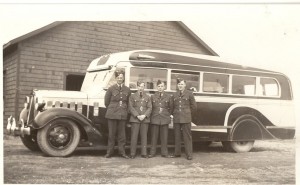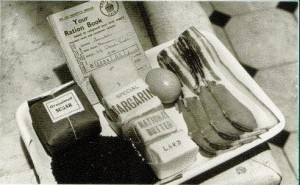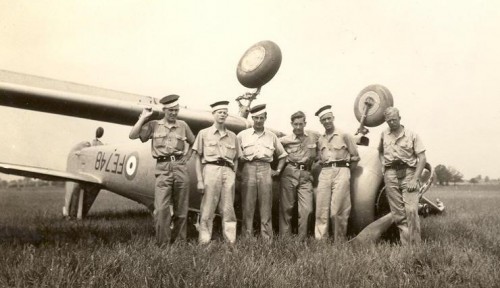As it was in the beginning at No. 31, the shortage of a bus remained a problem for the airmen at Gananoque Airport. They had to rely on supply trucks, walk the six-plus miles one way, hire a taxi or, as some did, share the ownership of a car.
Ex-R.A.F. Bill Westwood, who married a local girl and returned to Gananoque to live, owned a share in such a car. It came to a sorry end, but this is his story:
“Four of us pooled our money and bought a 1928 Studebaker for $60. It was a great car and got us back and forth without too much trouble. One day as I was hurrying back to camp for duty, I had a flat tire and was able to repair it temporarily by stuffing it with grass. The gasoline ration book was supposed to be in the car at all times as you had to show you had a coupon for a gallon of gas before the garage would put it in the tank. In those days, a gallon of gas cost twenty-five cents.
“The last drive I took in the car happened late one night when I ran out of gas before I reached the road to the airport. I pushed the car off the side of the road intending to take a bit of gas in the morning, enough to get it back to camp. I couldn’t get away until the afternoon and when I went back to the car, I found it turned over in the ditch. We learned that soldiers from Barriefield had been out that night practicing how to drive in black-out conditions before being sent overseas. As the convoy drove down the road, one of their trucks struck the car and the force pushed it over onto some rocks at the bottom of the ditch. The Army wanted to pay us something for it but we didn’t want the bother, so we sold it to a man in town for $25. He towed it away but we never saw the money.”
Bill continued with another car story with a sorry end that involved four pupils stationed at Gananoque:
“Four F.A.A. pupils discovered a Model-T Ford stored under a hay stack on a farm in the South Lake area; I think they had seen a glimpse of it from the air. So they asked the farmer if he’d sell it to them, which he did – I think they paid about $10. When leave came up, they headed to New York City driving their Model-T. It was in excellent condition and while they were there someone saw it and offered them a newer model Plymouth for their car. That was too good a deal to pass up so they agreed. As they were coming through Customs, they were asked for the ownership and the bill of sale – neither of which they had. To their chagrin, the car was seized and they were left to walk across the Bridge and then they hitchhiked back to camp. A poor ending to their first trip to the U.S.”

Gananoque Airport bus donated courtesy of The Robert Simpson Company.
No. 53 Course consisting of one naval officer and thirty-four naval ratings successfully completed training on July 31. The strength of aircraft at the end of the month: Harvards 120; Battles 4, Ansons 8, Lysanders 3. The strength of the Unit: Officers 105, W/Os 15, F/Sgts. and Sgts. 102, Other Ranks 1007, Civilians 13. Fleet Air Arm pupil pilots: Officers 16, Other Ranks 250.
BODIES RECOVERED
LAC OLDFIELD AND A/LA G. D. ASKEW
On August 2 and 5, the bodies of LAC Oldfield and A/LA G. D. Askew were recovered from Lake Ontario. LAC Oldfield had crashed into the Lake in the vicinity of Brothers Island (near Amherst Island) on November 20, 1941. A/LA Askew had died when the sailing boat he was on capsized June 16, 1942. (See page 53) They were buried with full military honours at Cataraqui Cemetery.
On August 14, Course 54 graduated with four naval officers and thirty naval ratings completing the course. The C/O’s diary reported that the “following wastages have occurred during the training of this Course – five naval ratings withdrawn from training, three naval ratings killed in flying accidents, and one transferred to No. 60 Course.”
No. 62 Course arrived at the station with a complement of three officers and thirty-eight naval ratings. On the 21st another group of one officer and thirty-nine naval ratings arrived for inclusion in No 63 Course. No. 55 Course graduated with two officers and thirty-one naval ratings earning their wings. On the 28th, Course No. 64 arrived consisting of one officer, one Petty Officer and thirty-eight Acting Leading Airmen on September 10, and the next day Course 56 graduated with three officers and thirty-two ratings. The increased training is evident in the rapidly arriving courses and numbers of pilots completing their courses.
After a two-year posting at No. 31, in September 1942 a group from the first echelon returned home and shortly afterwards two more groups left. The airmen were always talking about ‘the boat’ which would take them back to “England, home, and no butter, sugar, tea, coffee, cigarettes, or matches”. Ex-LAC Stan Allott said he left most of his personal things here and filled his kit bag with essential items rationed at home.

An English photo of one week’s food rationing for one adult. This extreme rationing was due to Hitler’s plan to starve the U.K. into submission using U-boats patrolling the Atlantic in Wolf Packs.
The Allied ships convoying the Merchant Marine and freighters had little to protect them with once they were in the mid-Atlantic (referred to as the “black pit”) because of the lack of long-range aircraft. In 1942 the losses reached their peak with 1,664 sunk and supplies of petrol and food to Britain were critically low. In 1943, with sufficient aircraft carriers and long-range aircraft, the balance changed in favour of the Allies. P.M. Winston Churchill called this “The Battle of the Atlantic,” and it was to him the dominant factor all through the war. It was the longest running military battle and he said everything happening elsewhere – on land, or sea, or in the air – depended ultimately on its outcome.
Photo Op At The Farm

On the right is airman Geoff Redman